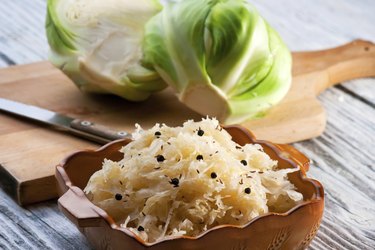
Sauerkraut has some impressive nutritional benefits. It's a fat-free, low calorie food, and a good source of fiber, iron and vitamins C and K. As a naturally fermented product, it's also a probiotic. The bad news is this: sauerkraut is so high in sodium that it should only be enjoyed in small amounts to avoid consuming an excessive amount of salt.
Fermented Foundation
Video of the Day
Seasonings are sometimes added, but basic sauerkraut consists of nothing but cabbage and salt. When shredded or thinly sliced cabbage is mixed with salt and allowed to sit, the salt pulls sugar-rich juice out of the cabbage. Over time, the juice and sugar ferment to produce sauerkraut. This natural fermentation process produces the type of live bacteria good for you, so fresh sauerkraut is a probiotic. You won't know how much healthy bacteria you might ingest, especially in small portions. However, probiotics support healthy bacteria in your gastrointestinal tract, boost your immune system and help synthesize vitamins.
Video of the Day
Good, Bad and Sneaky
The Centers for Disease Control and Prevention report that 90 percent of the sodium in a typical diet comes from food purchased at a store or restaurant. In other words, it's already in the food you buy and all you can do is pay attention to the amount in the portion you eat. The recommended daily intake -- 1,500 milligrams -- is enough to fill sodium's vital roles. It's essential for your nerves and muscles to work properly, including your heart muscles, and it regulates the amount of water in your body. When you consume too much sodium, your body retains water, blood volume increases and blood pressure goes up.
Sad Sodium News
Low-sodium foods contain fewer than 140 milligrams of sodium per serving, while sodium-free foods must have less than 5 milligrams in a serving, notes Colorado State University. These values give some perspective on the sodium in sauerkraut. One-quarter cup of canned, drained sauerkraut has 235 milligrams of sodium and a 1-cup serving jumps to 939 milligrams. The lower amount provides 16 percent of an entire day's sodium, while the larger serving supplies 63 percent of your daily sodium. Getting this much sodium from one small part of your daily diet makes it difficult, if not impossible, to stay within the recommended daily intake.
Reduce the Danger
If you make your own sauerkraut, do not use less salt to reduce the amount of sodium in the final product. The University of Alaska warns that omitting salt may result in spoiled cabbage rather than fermented sauerkraut. Draining the sauerkraut helps lower its sodium content; undrained sauerkraut may have as much as double the sodium, according to the USDA Nutrient Database. You'll reduce the sodium more by rinsing the sauerkraut under cold water after it's drained. Low-sodium sauerkraut may cut the total sodium by half, but check the label because the amount of sodium varies depending on the brand.
- Linus Pauling Institute: Sodium (Chloride)
- Nutrition 411: Probiotics and Prebiotics
- University of Alaska Fairbanks: Sauerkraut
- Centers for Disease Control and Prevention: Vital Signs -- Food Categories Contributing the Most to Sodium Consumption -- United States, 2007-2008
- Colorado State University Extension: Understanding the Food Label
- USDA Nutrient Database for Standard Reference: Sauerkraut, Canned, Solids and Liquids
- USDA Nutrient Database for Standard Reference: Sauerkraut, Canned, Low Sodium